History and Names of 3rd Regiment
The Third Regiment U.S.C.T. – A History
The enlisted men of this regiment were principally from the interior of Pennsylvania. They rendezvoused at Camp William Penn, at Chelton Hills, a few miles north of Philadelphia, where the regiment was organized in August, 1863, with the following field officers: Benjamin C. Tilghman, Colonel; Ulysses Doubleday, Lieutenant Colonel; Frederick W. Bardwell, Major. Colonel Tilghman had commanded the Twenty-sixth Pennsylvania, until wounded at Chancellorsville. Soon after its organization, the Third was ordered to the Department of the South, and proceeded thither, arriving at Morris Island while the siege of Fort Wagner was in full progress. It was immediately put into the trenches, and shared in the hardships of that memorable trial of skill and endurance which resulted in the fall of the fort. The loss during this siege was six killed and twelve wounded. In one of the night attacks which resulted in the capture of a line of rifle-pits, a Corporal was reported missing. Two days after, the advance sappers came upon his dead body. Warned by previous experience, they were careful to examine it thoroughly before attempting to remove it. A small string was discovered attached to its leg, which led away to the trigger of a torpedo buried in the sand. Such was the warfare which this command was called to meet.
Early in the year 1864, the regiment moved to Florida, with the forces under General Truman Seymour. On the return of the troops to Jacksonville, after the disastrous battle of Olustee, the Third was drilled as a heavy artillery regiment, and garrisoned the forts around the town, one company being posted at a fort on the St. John’s River below, and one at Fernandina. During the summer, Colonel Tilghman was employed on detached duty at the north, the command of the regiment devolving on Lieutenant Colonel Doubleday. Under the latter, it took part in several expeditions into the interior, undertaken by General William Birney.
In September, Colonel Tilghman returned and resumed command. Small parties were frequently sent out into the surrounding country, the expeditions occasionally extending far into the interior, for the purpose of bringing in contrabands, and destroying property belonging to the rebel government. On one occasion, a body of twenty-nine enlisted men of the Third, and one private of another regiment, all under command of Sergeant Major Henry James, proceeded about sixty miles up the St. John’s in boats, rowing by night, and hiding in the swamps by day, marched thence thirty miles into the interior, gathered together fifty or sixty contrabands, besides several horses and wagons, burned store-houses and a distillery belonging to the rebel government, and returned bringing their recruits and spoils all safely into camp.
On their return, they were intercepted by a body of cavalry, which was beaten off after a brisk fight, and they succeeded in crossing the St. John’s without loss, carrying with them their wounded. The courage and good conduct displayed by the party in this affair, composed as it was, entirely of colored soldiers, were highly creditable, and were commended in an order by the General commanding the Department of the South. It was somewhat remarkable, that the regiment never lost a man as prisoner, though raiding parties not unfrequently were beaten, and driven by superior numbers. The general feeling among the men seemed to be, that immediate death was preferable to the treatment likely to be experienced as prisoners, On one occasion, a soldier who had been surrounded and driven into the river, stubbornly refused repeated calls to surrender, and was killed on the spot.
After the cessation of hostilities, and the surrender of the rebel armies, the regiment was posted at Tallahassee, Lake City, and other points in Florida. On the 16th of May, 1865, Colonel Tilghman resigned, and Major Bardwell was appointed to succeed him, Lieutenant Colonel Doubleday having been promoted to Colonel of the Forty-fifth Colored, in the October previous. The regiment remained in service in Florida, until October, when it returned to Philadelphia, where, on the 30th, it was mustered out of service.
Source:
Bates, Samuel P. History of the Pennsylvania Volunteers, 1861-65, Harrisburg, 1868-1871.
Organization:
Organized at Camp William Penn, near Philadelphia, Pa., August 3-10, 1863.
Ordered to Dept. of the South.
Attached to 4th Brigade, Morris Island, S.C., 10th Corps,
Dept. of the South, to November, 1863.
3rd Brigade, Morris Island, S.C., 10th Corps, to January, 1864.
Montgomery’s Brigade, District of Hilton Head, S. C., 10th Corps, to February, 1864.
2nd Brigade, Vodges’ Division, District of Florida, Dept. of the South, to April, 1864.
District of Florida, Dept. of the South, to October, 1864.
4th Separate Brigade, District of Florida, Dept. of the South, to July, 1865.
Dept. of Florida to October, 1865.
Service:
Siege of Forts Wagner and Gregg, Morris Island, S.C., August 20-September 7, 1863.
Action at Forts Wagner and Gregg August 26.
Capture of Forts Wagner and Gregg September 7.
Operations against Charleston from Morris Island till January, 1864.
Moved to Hilton Head, S.C., thence to Jacksonville, Fla., February 5-7,
and duty there as Heavy Artillery till May, 1865. (1 Co. at Fernandina, Fla.)
Expedition from Jacksonville to Camp Milton May 31-June 3, 1864.
Front Creek July 15.
Bryan’s Plantation October 21.
Duty at Tallahassee, Lake City and other points in Florida May to October, 1865.
Mustered out October 31, 1865.
Source:
Dyer, Frederick H. A Compendium of the War of the Rebellion Compiled and Arranged from Official Records of the Federal and Confederate Armies, Reports of he Adjutant Generals of the Several States, the Army Registers, and Other Reliable Documents and Sources. Des Moines, Iowa: The Dyer Publishing Company, 1908
Third Regiment – USCT Newspaper Reports
Philadelphia Inquirer Thursday, July 30, 1863
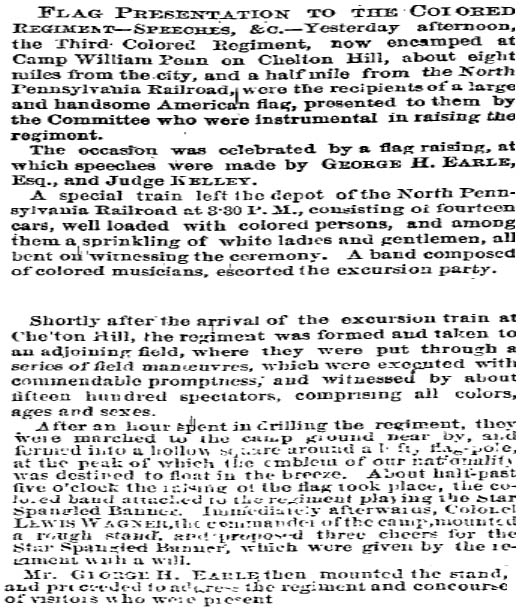
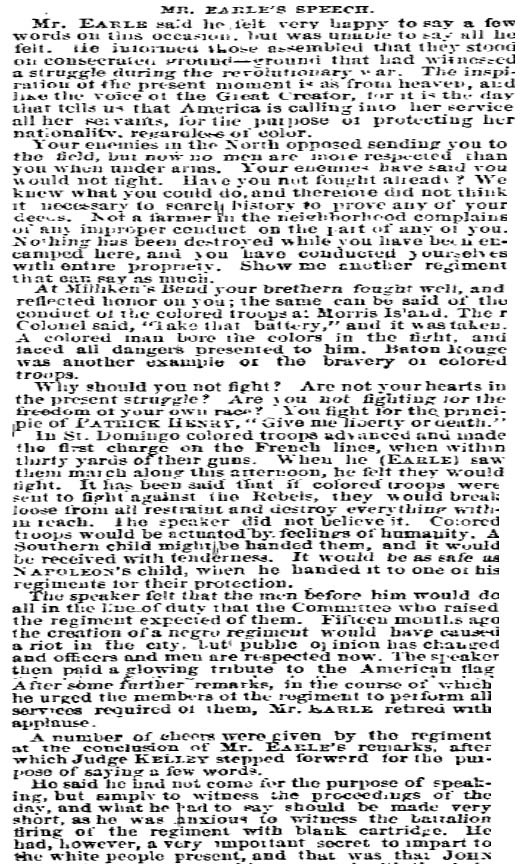
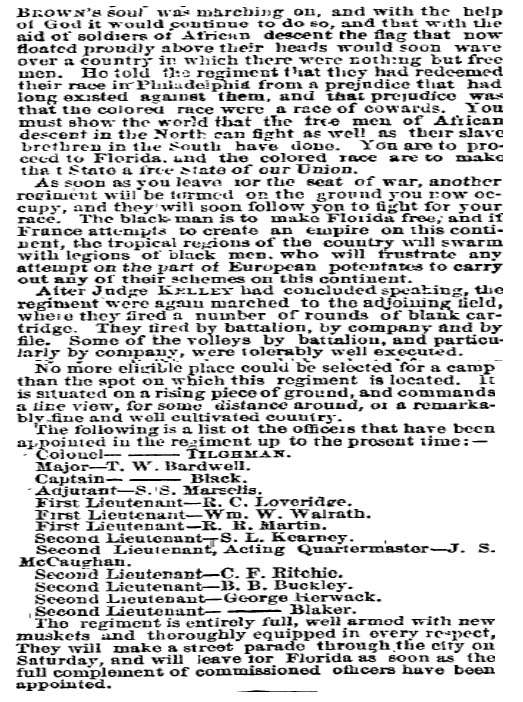
Philadelphia Inquirer August 5, 1863
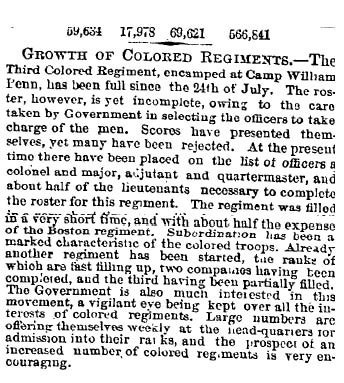
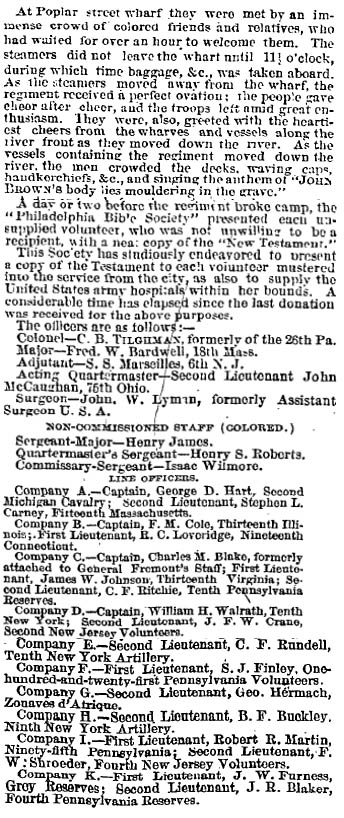
Philadelphia Inquirer August 16, 1863
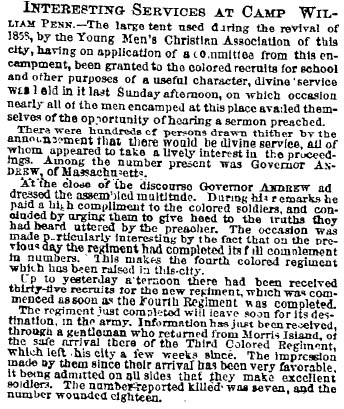
The Battle of Fort Wagner #1
Also called First Assault, Morris Island and Battery Wagner
July 11, 1863
When referencing or speaking about Fort Wagner, the name of the 54th Massachusetts Infantry and the heroics of the black soldiers as exemplified in the cinema Glory comes to mind. However what was depicted in the movie and most history books document is the “Second Battle of Fort Wagner.”
The first Union attempt to capture Fort Wagner took place on July 11, 2013 one week earlier than the second battle. On July 10, Union artillery on Folly Island together with Rear Admiral John Dahlgren’s fleet of ironclads opened fire on Confederate defenses of Morris Island. The bombardment provided cover for Brigadier General George C. Strong’s brigade, which crossed Light House Inlet and landed by boats on the southern tip of the island. Strong’s troops advanced, capturing several batteries, to within range of Confederate Fort Wagner. At dawn, July 11, Strong attacked the fort. Soldiers of the 7th Connecticut reached the parapet but, unsupported, were thrown back.
Brigadier General George C. Strong
Fort Wagner was an important part of the defenses’ of Charleston, South Carolina. The fort was built after the start of the American Civil War. It commanded one approach into Charleston Harbor, as well as providing protection for Fort Sumner. If it fell into Union hands, then it would provide a perfect base for the bombardment of that fort, and dramatically weaken the Confederate grip on South Carolina.
Unfortunately for any attacker, Fort Wagner was well situated on the northern tip of Morris Island, protected by the sea to the east and a swamp to the west. The only possible line of attack was from the south, straight into the teeth of the Confederate guns. At the start of July the fort had a garrison of 1,352 men, commanded by Brigadier-General William Taliaferro.
General William Booth Taliaferro
July 1863 saw a determined Union attack on Charleston. New army and navy commanders, determined to make their mark, decided to start with the capture of Fort Wagner. At the start of July they landed at the south end of Morris Island, and prepared for an assault. On July 10, Union artillery on Folly Island together with Rear Admiral John Dahlgren’s fleet of ironclads opened fire on Confederate defenses of Morris Island.
The bombardment was to provide cover for Brigadier General George C. Strong’s brigade, to cross Light House Inlet and land by boats on the southern tip of the island. Strong’s troops advanced, capturing several batteries, until they were within range of Confederate Fort Wagner.
The first attack began at dawn on Saturday, July 11, 1863. One brigade, the 7th Connecticut, commanded by Brigadier-General George C. Strong, launched an attack that reached the parapet of the fort before being forced back with heavy losses (339 Union losses compared to only 12 Confederate). If the attack had been abandoned at this point then it all but certain the attack would have not made much or perhaps almost forgotten in the history books. However, a second attack was ordered, and it was this attack that made a long term impact.
The reason for that impact was the selection of the 54th Massachusetts regiment to lead the attack. This regiment was the North’s crack black unit, but it had not yet been involved in a major battle. The attack on Fort Wagner would be its first real test.
In the gap between assaults, the Confederate garrison was reinforced until it was 1,785 strong. The Union attack would be made by two brigades – Strong’s and Haldimand S. Putnam’s. The 54th Massachusetts, under Colonel Robert Gould Shaw, joined Strong’s brigade after the first attack.
Union Regiments in the Battle Of Fort Wagner #1:
|
Four companies of the 7th Connecticut Regiment were in Strong’s’ Brigade, and were engaged in the first assault on Fort Wagner on July 11, 1863, In the assault which reached the parapets of the fort they displayed unusual gallantry. Of four Companies, A, B, I and K engaged in carrying out the assault with 191 officers and men had casualties of 103 who were killed, wounded or missing.
After the first Battle of Fort Wagner, Companies A, B, I and K were assigned to 1st Brigade, Morris Island, S.C., 10th Corps
Shown below is a postcard Image of the 7th Connecticut Regiment charging the ramparts of Fort Wagner, where unsupported they were repulsed.
William F. Chambrés
Member
Company of Military Historians

